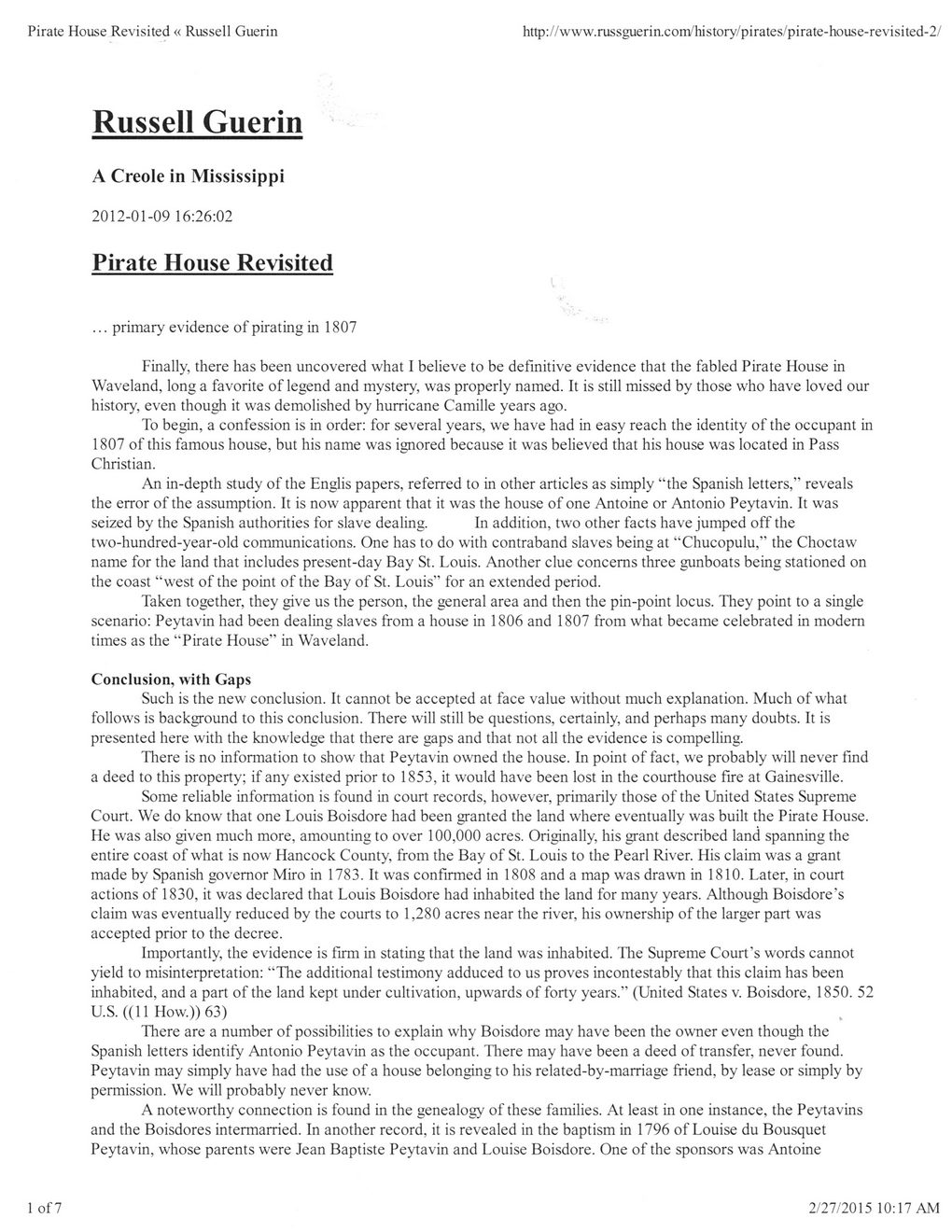This text was obtained via automated optical character recognition.
It has not been edited and may therefore contain several errors.
Pirate House Revisited « Russell Guerin http://www.russguerin.com/history/pirates/pirate-house-revisited-2/ Russell Guerin A Creole in Mississippi 2012-01-09 16:26:02 Pirate House Revisited ... primary evidence of pirating in 1807 Finally, there has been uncovered what I believe to be definitive evidence that the fabled Pirate House in Waveland, long a favorite of legend and mystery, was properly named. It is still missed by those who have loved our history, even though it was demolished by hurricane Camille years ago. To begin, a confession is in order: for several years, we have had in easy reach the identity of the occupant in 1807 of this famous house, but his name was ignored because it was believed that his house was located in Pass Christian. An in-depth study of the Englis papers, referred to in other articles as simply “the Spanish letters,” reveals the error of the assumption. It is now apparent that it was the house of one Antoine or Antonio Peytavin. It was seized by the Spanish authorities for slave dealing. In addition, two other facts have jumped off the two-hundred-year-old communications. One has to do with contraband slaves being at “Chucopulu,” the Choctaw name for the land that includes present-day Bay St. Louis. Another clue concerns three gunboats being stationed on the coast “west of the point of the Bay of St. Louis” for an extended period. Taken together, they give us the person, the general area and then the pin-point locus. They point to a single scenario: Peytavin had been dealing slaves from a house in 1806 and 1807 from what became celebrated in modem times as the “Pirate House” in Waveland. Conclusion, with Gaps Such is the new conclusion. It cannot be accepted at face value without much explanation. Much of what follows is background to this conclusion. There will still be questions, certainly, and perhaps many doubts. It is presented here with the knowledge that there are gaps and that not all the evidence is compelling. There is no information to show that Peytavin owned the house. In point of fact, we probably will never find a deed to this property; if any existed prior to 1853, it would have been lost in the courthouse fire at Gainesville. Some reliable information is found in court records, however, primarily those of the United States Supreme Court. We do know that one Louis Boisdore had been granted the land where eventually was built the Pirate House. He was also given much more, amounting to over 100,000 acres. Originally, his grant described land spanning the entire coast of what is now Hancock County, from the Bay of St. Louis to the Pearl River. His claim was a grant made by Spanish governor Miro in 1783. It was confirmed in 1808 and a map was drawn in 1810. Later, in court actions of 1830, it was declared that Louis Boisdore had inhabited the land for many years. Although Boisdore’s claim was eventually reduced by the courts to 1,280 acres near the river, his ownership of the larger part was accepted prior to the decree. Importantly, the evidence is firm in stating that the land was inhabited. The Supreme Court’s words cannot yield to misinterpretation: “The additional testimony adduced to us proves incontestably that this claim has been inhabited, and a part of the land kept under cultivation, upwards of forty years.” (United States v. Boisdore, 1850. 52 US. ((11 How.)) 63) There are a number of possibilities to explain why Boisdore may have been the owner even though the Spanish letters identify Antonio Peytavin as the occupant. There may have been a deed of transfer, never found. Peytavin may simply have had the use of a house belonging to his related-by-marriage friend, by lease or simply by permission. We will probably never know. A noteworthy connection is found in the genealogy of these families. At least in one instance, the Peytavins and the Boisdores intermarried. In another record, it is revealed in the baptism in 1796 of Louise du Bousquet Peytavin, whose parents were Jean Baptiste Peytavin and Louise Boisdore. One of the sponsors was Antoine 1 of 7 2/27/2015 10:17AM

Pirate House Document (014)